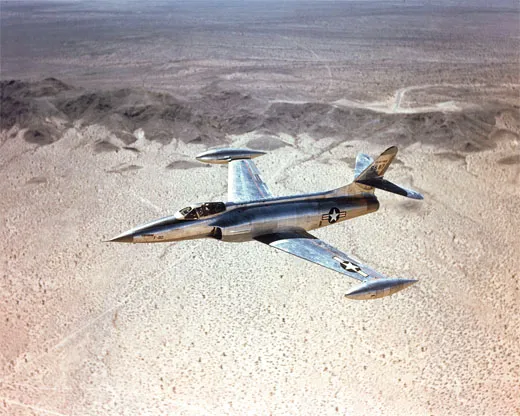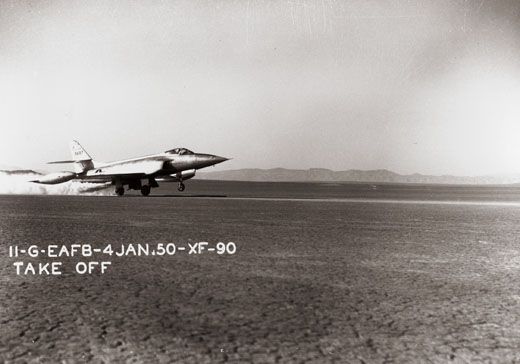Nukes vs. Airplanes
Between the F-80 and the F-104, a supersonic pioneer fought the Cold War…in its own way.
/https://tf-cmsv2-smithsonianmag-media.s3.amazonaws.com/filer/xf-90-631.jpg)
On April 22, 1952, dozens of journalists and approximately 2,000 military personnel watched as a 31-kiloton nuclear bomb exploded above the Nevada Proving Ground. Operation Tumbler-Snapper, as the series of atmospheric tests was called, was designed to evaluate the vulnerability of parked aircraft to an atomic bomb blast. Among the aircraft gathered there was one of the hottest-looking fighters ever built: Lockheed’s XF-90.
The needle-nose fighter followed Lockheed’s F-80 Shooting Star, the first U.S. jet fighter to see action, and was an important precursor to the “missile with a man in it,” the F-104 Starfighter. And though only two were built, the XF-90’s dashing good looks earned it movie-star status throughout the 1950s—far beyond its operational life—attracting readers and advertisers to prominent aviation periodicals and comic books of the time. As a single-engine F-90B, it made a splashy cover for the September 1953 comic book Blackhawk. Thereafter, a generation of young Boomers dazzled by futuristic aviation technology awaited each new adventure of American pilot Blackhawk, his buddy Chuck, and their coalition of international fighter jocks manning a fleet of six sleek F-90Bs in the quest to take down the “Red Tide” thugs of the atomic age.
The F-90 was the first U.S.-built, swept-wing jet to use afterburners as standard equipment and have wingtip fuel tanks and a fully adjustable fin and stabilizers. Fowler flaps and leading-edge slats improved airflow over the wings, making the F-90 one of the pioneers in 35-degree swept-wing technology. In tests, the hot rod exceeded Mach 1 fifteen times.
So how did such a capable aircraft, one that so captured the public’s imagination, become atomic bomb test fodder?
After World War II, the U.S. Army Air Forces needed a “penetration fighter,” capable of escorting bombers to and from their targets. The early jet fighters had been far from perfect, and their notorious fuel consumption decreased their range. In 1945, the AAF issued a request for a fighter with a combat radius of about 900 miles. Competing for the contract against McDonnell’s XP-88A and North American’s XP-86C, Lockheed’s team, headed by Clarence “Kelly” Johnson and Willis Hawkins, went through 65 versions before settling on the swept-wing design of the XP-90. (In 1948, the P designation, for “pursuit,” was changed to F, for “fighter.”)
Johnson pushed the group to produce two twin-engine prototypes, whose appearance inspired the team to coin the nickname Big Broad-Breasted Turkey. “Its front view with the broad fuselage and side inlet ducts gave it the broad-breasted look,” says Jim Beach, the engineer who pioneered the XF-90’s canopy actuation and ejection system. “Jim Pray, the windshield designer, dubbed it a ‘turkey’ due to its wimpy engines.”
Testing of the “wimpy” engines began on the ground at Burbank, California, but the first XF-90 was trucked to the North Base of Muroc Air Force Base, now Edwards Air Force Base, in 1949 for flight testing by Tony LeVier, Lockheed’s chief test pilot.
Lockheed assigned flight test engineer Ernest Joiner to the project. “Very little was known at that time about what happened to an airplane when it exceeded the speed of sound,” Joiner recalls. “There were all kinds of weird ideas that the airplane would be subjected to very high structural loads. This lack of information contributed to the XF-90 being the strongest airplane anyone had ever seen. Of course, the sound barrier had been broken by Chuck Yeager in the X-1 research aircraft in October 1947, but [that didn’t happen] in time to have much influence on the design of the XF-90.”
It fell to Chuck Buzzetti, a research engineer in the flight test organization, to evaluate the strain gauges used to measure the wing loads on the heavy aircraft. “The main I-beam of the F-90 resembled a bridge girder,” says Buzzetti.
Due, in part, to its aluminum skin—four times more stress-resistant than the standard alloy of the day, and a feature that enabled the aircraft to withstand 12 Gs—the single-seat fighter weighed as much as a DC-3, and was almost 71 percent heavier than an F-86, so its Westinghouse engines were seriously underpowered. The team could only hope the airplane would survive its test flight.
“I’ll never forget one flight Tony made on May 17, 1950,” recalls Joiner. “It was one of the times when Kelly [Johnson] was there. The test program was to conduct power-on dives to work up to the so-called sound barrier. We were on the radio with Tony as he made a dive at fairly low altitude. We could see the airplane on the other side of the dry lakebed. It disappeared in the haze. At that moment we heard a tremendous explosion. There is no doubt that both Kelly and I thought that the airplane had augured in. I was afraid that Kelly was going to have a heart attack. Within a very short time Tony called in on the radio. Talk about relief! He had dived the airplane to Mach 1.12 and everything was fine. You have to realize that we hadn’t heard a sonic boom before. I’m not sure about Kelly but there’s a good chance he hadn’t heard one either. Tony went on to exceed the speed of sound a number of times, and the XF-90 handled fine. It certainly experienced no problems structurally.”
Despite the aircraft’s attributes, the need for an all-purpose fighter was declining. “It had become obvious to everyone that this do-everything fighter was not a good idea,” says Joiner. “I guess you could say it was a jack of all trades but master of none.”
In 1950, the Air Force awarded its contract to the McDonnell XF-88A. With the outbreak of the Korean War, however, the Air Force needed combat airplanes in a hurry, and looked to the existing F-80, and the F-86, which was already in production. The exhausted Lockheed team turned to other projects. LeVier would later observe, “Sometimes it is better to chalk an airplane off as experience and go on to something else.”
The company retired the two prototypes to careers as structural test subjects. The first prototype was tested to destruction at the National Advisory Committee for Aeronautics Laboratory in Cleveland. The second XF-90 (along with other aircraft, including a B-45, a B-29, F-47s, and B-17s) was sent to the Nevada Proving Ground for use in a nuclear weapons test. Secured about a half-mile from ground zero, and nose-in to the first two blasts, the XF-90 survived a one-kiloton shot on April 15, 1952, with undamaged wings, but sustained enough dents and cracks—not to mention the buckling of a fuselage fire door—that it would have taken approximately 106 hours to repair. A second, 31-kiloton blast a week later bent the aircraft’s nose. For the third blast, 19 kilotons detonated on May 1, the XF-90 was positioned perpendicular to the shock wave. The blast severed the tail and blew the landing gear from the wing; the main wing structure was buckled and scorched.
The Nevada Test Site later suspended above-ground tests. After a 5.3-kiloton underground blast, in December 1963, the XF-90’s contaminated, cracked, and partially scorched frame was moved to NTS Area 11, where it was used in Broken Arrow exercises in which crews trained for recovery of a downed airplane with a nuclear payload.
The aircraft was officially documented as destroyed— “vaporized, people thought,” says Robert E. Friedrichs, a physical scientist at the National Nuclear Security Administration’s Nevada Site Office. But flying over the test site a few years later, Ernest Joiner saw something unexpected: “Looking down, we could see the XF-90. It appeared to be intact.”
Friedrichs recognized the fighter’s historic significance. “There were some things about that airplane that I thought were phenomenal,” says Friedrichs. “The fact that the aircraft survived at all is a story that needed to be shared.”
When Friedrichs served as a scientist at the Nevada Test Site, he got a first-hand look at the remains of the airplane as it sat on a dry lakebed over several decades. “Since only two were built and one was destroyed, in the late 1980s I got the process started of getting this aircraft preserved for presentation in a museum,” he says. For 13 years Friedrichs forged through bureaucratic snags: He assessed the aircraft’s historic value, contacted museum curators, organized funding, and found contractors to retrieve and decontaminate the airplane after five decades of radioactive decay.
In 2001, Friedrichs found a home for the XF-90 prototype: the National Museum of the U.S. Air Force, near Dayton, Ohio. The museum’s director, retired Major General Charles D. Metcalf, recognized the important role the aircraft played in the beginning of the cold war as an experiment in early atmospheric testing of atomic bombs. “[The XF-90] had a lot of firsts,” he says, adding that the fighter will be used in an exhibition on “the people and events during the very inception of the cold war.”
Although the sleek fighter never made it into production, its participation in three atmospheric atomic bomb tests helped in waging the cold war. In a 1990 letter to the Nevada Division of Historic Preservation supporting the XF-90’s conservation, Donald Elle of the Department of Energy
noted: “Information derived from [the Tumbler-Snapper project] continues to be used in aircraft design and operational deployment today.”
Friedrichs met with radiation programs director James Seals and Fluid Tech, Inc. to figure out how to deconstruct, survey, and decontaminate each piece of the aircraft. Although Fluid Tech had experience in all types of contamination control, this was the first time the company would clean an aircraft.
Workers found the fuselage inhabited by a thriving colony of white-tail antelope squirrels. Because of the possibility the animals were carrying Hantavirus, Seals used a combination of bleach and sandblast to eradicate 40 years’ worth of nest debris. His crew, sweltering in full protective gear in the desert heat and carrying radiation detectors, scoured every surface, penetrating the smallest crevices to eradicate plutonium residue. During the summer, the crew disassembled and decontaminated the aircraft at night. “By midday it’s too hot,” Seals says of the desert, “even for the snakes.” Temperatures plummeted in the winter. Despite the extremes, the crew members completed the job within a year.
Along the way, they made a surprising discovery. The original Westinghouse engines had survived. “We’d never taken apart a jet engine before, but when we pulled them out, the turbines still turned,” says Seals. “You could push a turbine fin and spin those engines real easy.”
In 2003, a C-5 transport flew the decontaminated XF-90 parts from the Nevada Test Site to Wright-Patterson Air Force Base. It will take a year to reassemble the aircraft, says restoration division chief Roger Deere, who will prepare the airplane for exhibition. (While the XF-90 awaits restoration, visitors can see the fighter by taking a special behind-the-scenes tour.)
Although one aircraft on the Nevada Test Site, a B-17 bomber, was rebuilt and flown out, Friedrichs was hesitant to see someone try to fully restore the XF-90. “When you only have one left, you really don’t want to take the chance of flying it and possibly losing it,” he says. Instead, says Deere, “The exhibit will tell the story that the XF-90 has been through three nuclear blasts.” He admits, “It would be a major chore to restore it to a good, decent-looking airplane.” Instead, says Friedrichs, the public will see the XF-90 “exactly as it sat out here in the desert for half a century.”

